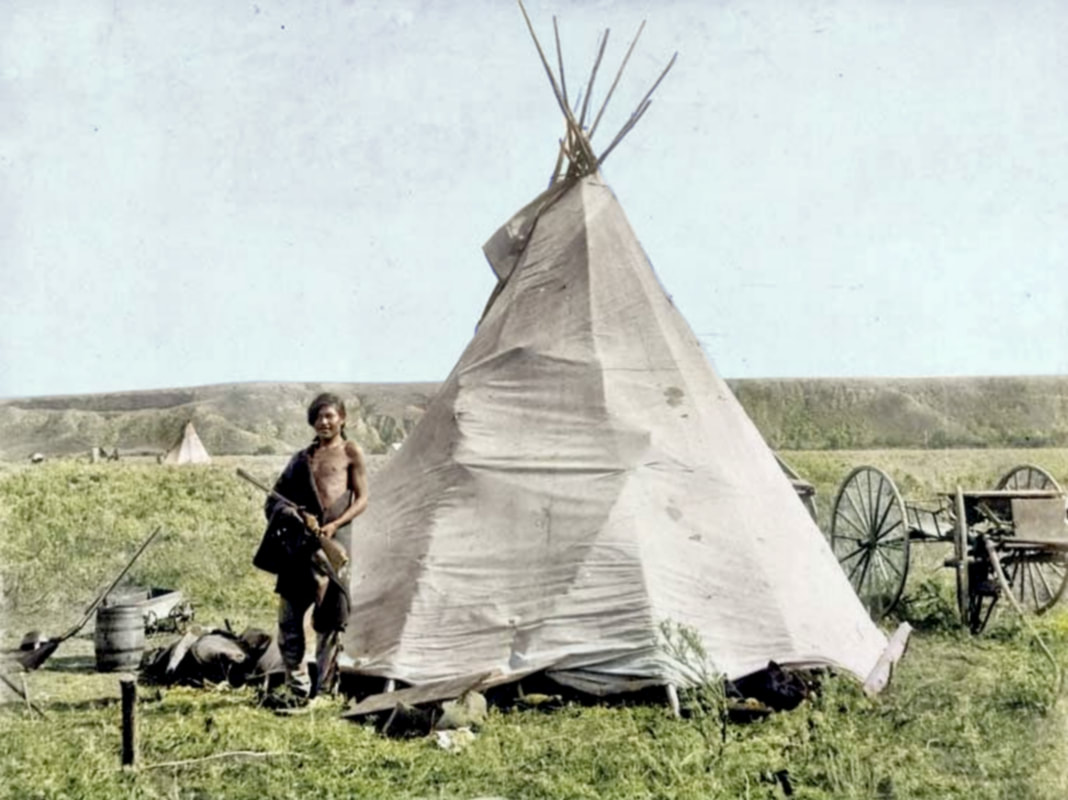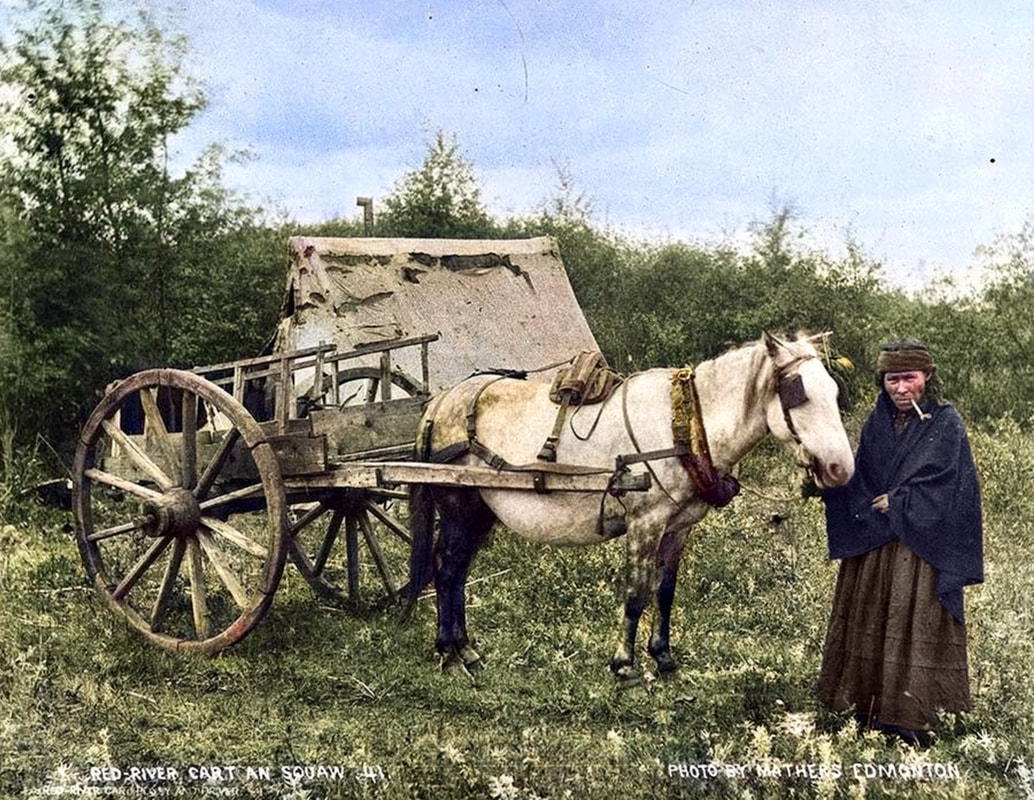|
By Kade Ferris In a Letter from the Secretary of the Smithsonian Institution, accompanying the Annual Report of the Board of Regents for the year 1879, a very vivid description of the Metis people was given. This description discussed such issues as the Metis homeland and settlements, the tribes from which the Metis derived their Indian blood and kinship, their housing, mode of dress, the linguistic aspects of the Metis people, and some of the family names of the Metis Nation. A highly detailed document, it provides a very good basis for additional research into the Metis people. METIS POPULATION In discussing homeland and community, the document states that the province of Manitoba, extending from the boundary line to Lake Winnipeg, is the great center of the Metis homeland. In this area, strong communities were concentrated around Winnipeg in places such as Fort Garry, St. Boniface, St. Vital, St. Norbert, St. Agatha, St. Anne, St. Charles, and St. Francis Xavier (or Grantstown). The population estimate for the area was place around 6,500 people, with an additional 500 living in various area around the shores of Lake Winnipeg, Lake Manitoba, and in the Rainy Lake district of Ontario. In the Saskatchewan district, the letter stated that many of the settlements were scattered along the Saskatchewan River, clustering around trading posts, and in Alberta settlements were most numerous along the base of the Rocky Mountains in places such as Fort Edmonton, St. Albert, and St. Anne, with the number residing in that area totaling around 2,500 Metis. At little Slave Lake (and vicinity) an additional 500 Metis were living, and other large concentrations include about 500 souls in the vicinity of Lac Labiche, 300 at Peace River and vicinity, and varying numbers of scattered families ranging as far north as the Great Slave Lake. Other places with concentrations of Metis included Turtle Mountain in what is now North Dakota, Wood Mountains in Saskatchewan, Cypress Hills in Saskatchewan and Alberta, Milk River and French Creek, Montana, and additional groups in British Columbia at the Fraser and Okanagan Rivers, Lakes Kamloops, Babine, and Stuart. The document estimated that over 33,000 Metis were living in the Canadian northwest. The letter also made a hypothetical guess that if the French-descended families outside the Metis homeland, stated to be “tainted with Indian blood”, residing in places such as eastern Canada, Illinois, and Missouri were included, perhaps an additional 7,000 people might be added to this total. BLOOD AND KINSHIP The letter also discussed some of the tribes to which the Metis were related by blood and kinship. These tribes included early admixture with Montagnais, Ottawa, and Huron, with limited mixing with Iroquois and Ottawa tribes. The majority of Metis, it states, derived their bloodlines from the Ojibwe, Cree, and Assiniboine, with minor influence of Dakota Sioux. Those Metis hailing from Saskatchewan were mostly of Cree extraction, Metis hailing from around Pembina, St. Joseph, Winnipeg, Rainy River, the Red River were mainly of Ojibwe and Saulteaux blood, while the Metis of Alberta northward to the Great Slave Lake were exclusively of Cree origin. The Metis who possessed Iroquois blood were small in number and hailed from around Lake Winnipeg and at areas near the Rocky Mountains. Of the other tribal bloodlines, a small proportion of Blackfeet and Montagnais Metis were known to be operating near the base of the Rocky Mountains; the Blackfeet Metis living in the south and the Metis with Montagnais blood living to the north with the Cree derived Metis. Metis with Assiniboine ties were more common in southern Manitoba, and northern North Dakota, and some groups with Ojibwe, Assiniboine, and Dakota Sioux blood were operating in the Red River and Devil’s Lake region of North Dakota. There were some Gros Ventre and Flathead associated Metis in Montana, with some Cree and Ojibwe Metis there as well, mostly in the Milk River region. HOUSING AND DRESS In terms of housing, the letter states that the average Metis house—especially those typical along the Red River—were small, one-story log structures with one, sometimes two or three rooms, and very sparsely furnished. In one corner of the principal room, the bed of the heads of the family were usually placed. An open fire-place, constructed to be tall and narrow—so as to accommodate logs placed upright—was along the middle of one of the walls. If possible, a table, dresser, and a few boxes serving duty as storage and as chairs, constituted the furniture. Almost all activities would happen in this room, including eating and sleeping. In their dress the Metis, it was noted, had a remarkable fondness for finery and gaudy attire. The Manitoba Metis men usually wore a blue overcoat (or capote) with conspicuous brass buttons, black or drab corduroy trousers, and a belt or sash around their waist, with garter leggings and moccasins. Their clothes would usually be variously adorned with colored fringes, scallops, and beads. Younger men might wear leggings made of blue cloth, which would extend to the knee, below which was tied with a gaudy garter with heavy bead work running down the outer seam. The Metis women generally dressed in a black gown with a black shawl thrown over the head, while young girls often wore a colored shawl about their shoulders and a showy bonnet or kerchief upon the head. The women loved the color scarlet and prized gaudy ribbons and jewelry. LANGUAGES
It was noted that the Metis generally spoke several languages, including one or more Indian dialects, French-patois, and often English. Most of the Metis residing in the United States could speak and understand English and used it when conversing with white men, but spoke their native language between themselves. Similarly, the Metis at Red River, Saskatchewan, and Milk River settlements, only spoke English when conversing with white men. In terms of Indian languages, the Metis around Rainy River westward spoke mostly Ojibwe, while the further west one went Cree became the language of choice. Many of the Metis in what is now North Dakota could speak Ojibwe, Dakota Sioux, and Cree, while in other places the dialect of the tribe from which they originated was spoke (e.g. Gros Ventre, Assiniboine, etc.) While French is understood by the Metis, the French is a patois that is not comprehensive but contains a large number of peculiar words and expressions grown out of the character of the land they live in, and their mode of life they live. Their pronunciation is generally understood by a Frenchman in spite of its difference, but the French spoke by the white man is not readily understood by the average Metis. SOME FAMILY NAMES The names of Metis, it was stated, were primarily derived from the original French Canadian families from the east. Some of the names found around the Lakes in Manitoba included: Bonaventure, Saint-Arnaud, De Montigny, Saint-Cyr, Saint-Germain, La Morandiére, and La Ronde. Farther north, names included: De Mandeville, Saint-George, Laporte, Saint-Luc, Racette, Lépinais, and De Charlais [Desjarlais]. Among the most common family names at Red River were: Boucher, Bourassa, Boyer, Cadotte, Capelette, Carrière, Charette, Delorme, Deschambeau, Dumas, Flamand, Garneau, Gosselin, Grand Bois, Gaudry, Goulet, Hupé, Larocque, Lucier, Lagemodière, Laderoute, Lepuie, Laframbaise, Letendre, Morin, Montreuil, Martel, Normand, Rinville, and Villebrun. Other common names included: Saint-André, Bellanger, Bonneau, Boucher, Baudry, Biron, Chevalier, Cadotte, Chenier, Deschamps, Frichette, Giroux, Gendron, Grondin, Hamelin, Lapierre, Lavallée, Lécuyer, Lévéque, Lusignau, Labutte, Lépine, Mainville, Nolin, Plaute, Pelletier, Perrault, Pilotte, Piquette, Riel, Saintonge, and Thibault. Further west, names like Gregoire, Maison, Lachapelle, Delorme, Vaudal, Lucier, Gervais, and Rondeau could be found. Some Metis names found in Montana included: Asselin, Jaugras, Moriceau, Lade route, Lafontaine, Larose, Lavallée, Poirier, Dupuis, Bisson, Houille, and Carrier. Some of the names found in British Columbia included: Allard, Boucher, Boulanger, Danant, Dionne, Durocher, Falandeau, Gagnou, Giraud, Lacroix, Lafleur, Napoleon, Perault. Some of the names that began with the “La” possibly originated in the wilderness and were not necessarily derived from white fathers. Other names could be found, and any of these names listed above, and others, could be found in and among all Metis communities. Some Scottish and English names were also present, but these are not listed. WORK In terms of work, the Metis could be found in a variety of positions working at trading posts as porters, laborers, and other positions. Many moved goods from place to place in their carts, and some were boatmen. Trading establishments also hired Metis men to serve as trappers and hunters to supply the posts with goods to sell and trade. Estimates are that about 25 percent of Metis were employed this way. Others served as guides and interpreters. The vast majority are hunters who are dependent on the buffalo and work the hide and pemmican trade. Their women are expert in tanning hides and robes. It is said that their bead-work was outstanding and they were very skillful in the ornamentation of furs and buckskin. REFERENCE: Annual Report of the Board of Regions for the year 1879, Smithsonian Institute, Washington: Smithsonian Institute.
9 Comments
Constance Neault Rohloff
11/13/2019 05:54:15 am
excellent
Reply
Louella Vincent
11/13/2019 06:53:40 am
My father is from Winnipeg and Métis , I would like to share this article on Facebook. How can I do this? Thank you
Reply
dibaajimowin.com
11/13/2019 07:00:46 am
You can share it by copying the link address from this page.
JR
11/21/2019 10:13:35 am
Curious about why you haven't included the Scottish and English named families, who were definitely part of these kinship networks. Are you differentiating between the half-breeds and the Metis?
Reply
11/21/2019 10:17:28 am
Not at all. There was no difference between Anglo and French Metis at all, as most intermarried freely and the kinship systems were intermingled. However, the Smithsonian article did not list any of the Anglo names, so they weren't listed in the posting by us.
Reply
Dave Charette
7/15/2020 07:00:44 pm
It's quite insulting that the author writes, “tainted with Indian blood”. Author must be very prejudice against Aboriginals. I for one is very proud of my Indian blood.
Reply
Dibaajimowin
7/15/2020 07:05:14 pm
Indeed. They weren't that enlightened in 1879.
Reply
William K Courage
3/12/2021 04:20:14 am
This is excellent info. on the Metis. I am a US citizen and have been all my life. I interestingly discovered my families past about 10 years ago. My grandmother was Metis from Saskatchewan. My mother was French Canadian. Although no Indigenous blood. Her grandparents and mother and father lived among the Metis in Minnesota in Lambert Township, a Metis community. They also lived in St. Boniface and St Jean Baptiste. My mother was adamant about not having any indigenous blood. My DNA proved that out. I am 6% Native American. Just a white boy from Montana who loves his family roots. I hope to get to know some of my dear Metis family soon.
Reply
Cindy Ducharme
3/1/2023 08:17:23 am
On the list of Metis names I don’t see Charron Ducharme or Ducharme. Metis family from St Anne Mb and St Rita
Reply
Leave a Reply. |
AuthorKade M. Ferris, MSc
Archives
June 2023
Categories |



 RSS Feed
RSS Feed
